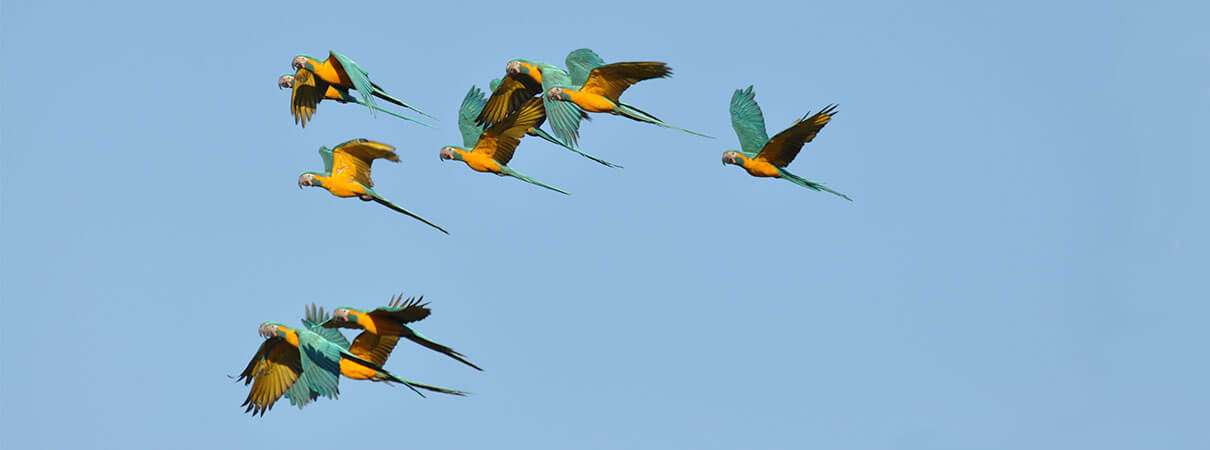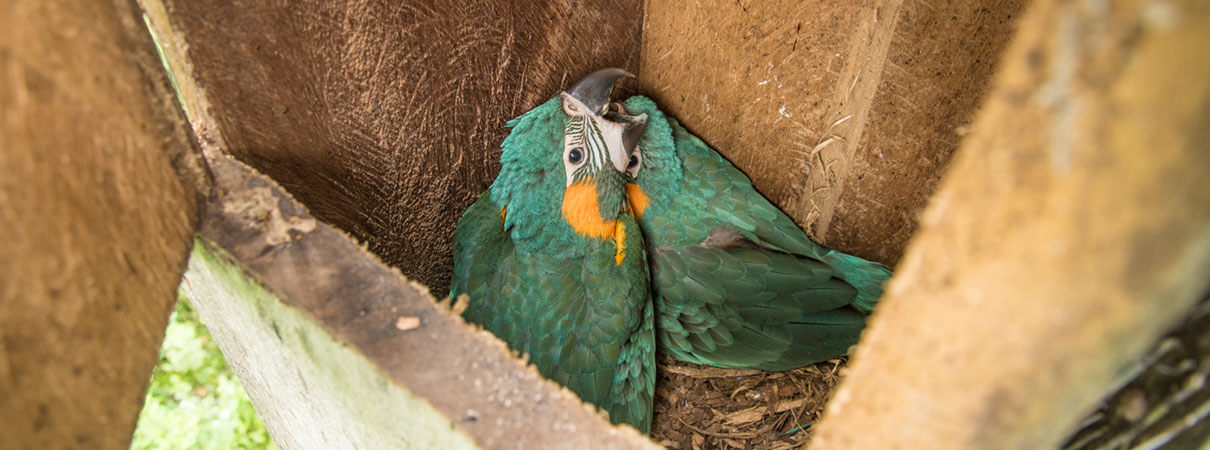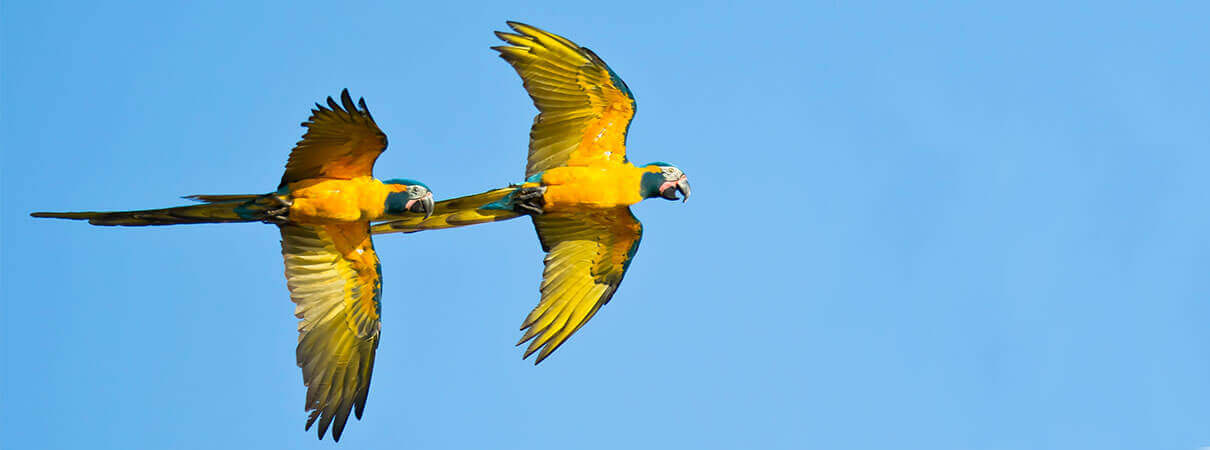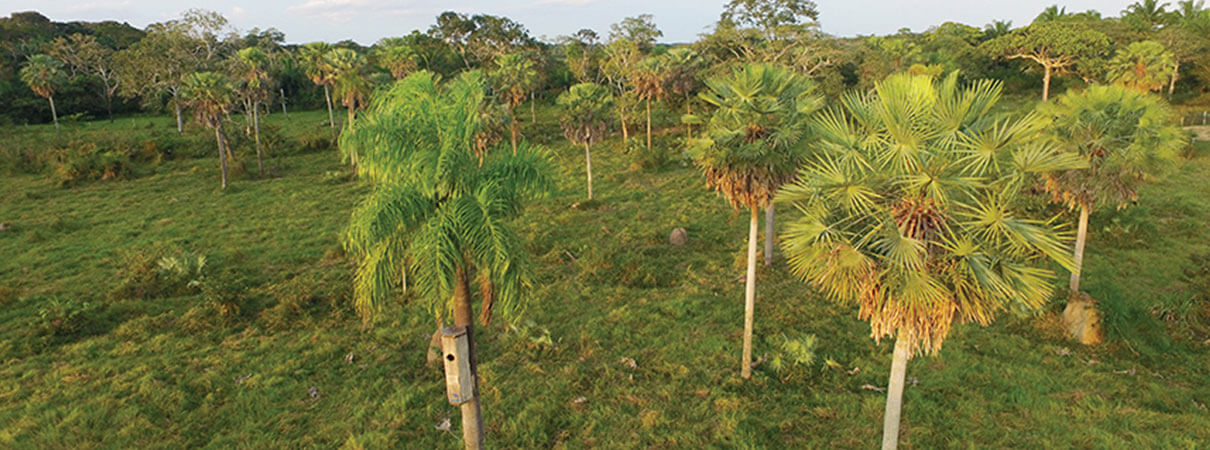Securing a Rare Bird's Nest Egg: Blue-throated Macaw Conservation
A new Bolivian reserve protects key nesting areas for the Critically Endangered Blue-throated Macaw
Thanks to decades of work by passionate scientists, conservation organizations, macaw lovers, and local people, the Blue-throated Macaw's odds of survival are increasing. Some dangers facing the bird have diminished, and protection measures helped boost the wild population to more than 400 individuals. The August 2018 creation of the Laney Rickman Blue-throated Macaw Reserve in Bolivia was the next milestone, protecting the bird's largest known nesting population.
“Securing the most important breeding site for this Critically Endangered species … is key to the long-term recovery of the species that began in 1998,” says Rodrigo Soria, Executive Director of the Bolivian conservation organization Asociación Armonía (Armonía), an ABC partner. “We are now witnessing the achievements from 20 years of hard work.”

Blue-throated Macaws. Photo by Sebastian Herzog
From Cattle Ranch to Conserved
The Blue-throated Macaw only lives in one very specific, and relatively impassable, place — the Beni Savanna in north-central Bolivia. The Beni is an expansive tropical grassland dotted here and there with palm-dominated “forest islands” defined by seasonal patterns of flooding and a severe dry season. On these slightly raised forest islands, the Blue-throated Macaw roosts, nests, and feeds on motacú palm and other fruits.
In Beni Department, many people work in the cattle ranching industry, with cows outnumbering people almost four to one. Many Beni residents still get around on horseback, as less than five percent of the roads are paved in the department's 82,458 square miles (an area a bit larger than Kansas).
The new Laney Rickman Blue-throated Macaw Reserve spans 1,680 acres of savanna and tropical forest. The land was purchased by Armonía in a joint effort with ABC, the International Conservation Fund of Canada, IUCN Netherlands, and World Land Trust.
Formerly a cattle ranch, the reserve is home to diverse wildlife, including Giant Anteaters, Crab-eating Foxes, and birds such as the White Monjita and Red-billed Scythebill. However, unlike these more widespread species, the reserve's namesake is found in few other locations.

Laney Rickman Nature Reserve. Photo by Asociación Armonía
A Tempting Prize for Smugglers
Its small range and limited population made the Blue-throated Macaw particularly vulnerable to population declines caused by capture for the illegal pet trade. This trade was once the main threat to Blue-throated Macaw conservation. Poverty rates are high in the Beni, and the macaw was a tempting prize. A ranch worker who captured a macaw could sell it for a high price. Often, the bird would then be smuggled out of the country and sold to buyers in Europe and other parts of the world.
“Before CITES (the Convention on International Trade in Endangered Species of Wild Fauna and Flora), the Blue-throated Macaw had a higher price tag than any other macaw in Bolivia,” says Bennett Hennessey, Development Director for Armonía and ABC's Brazil Program Coordinator.
Today, thanks to stricter laws, better enforcement, and a sustained and effective public education program launched by Armonía, illegal trade in Blue-throated Macaws has largely ceased. The education program set out to give Bolivians a feeling of national pride about their endemic macaw — a creature unknown to many people in the country and also focused at the local level, emphasizing how the paraba barba azul (Spanish for “blue-beard macaw”) is found only in the Beni Savanna, that it belongs to the people of Beni, and that they have the power to protect it. In 2015, the Bolivian government designated the Blue-throated Macaw a national heritage species.
Changing Attitudes: “That's Our Bird"
All in all, the change in public attitude has been striking, and occasional attempts to trade the bird are met with condemnation by local townspeople. According to Hennessey, the people in Beni now say, “Leave that bird alone. That's our bird.” With illegal trade greatly reduced, the biggest threat to the Blue-throated Macaw is now habitat loss. Cattle ranching is the main industry in much of the bird's range. Ranches bring people; those people need firewood and building materials, so they head to the forest islands to cut down large trees.
Sometimes ranchers burn the savanna to produce better grass for grazing. These fires can threaten macaw nests and prevent new trees from growing. In addition, cattle often chew young palms to the ground.
With fewer trees, especially palms, the Blue-throated Macaws have less fruit to eat and, more critically, fewer nest sites. Since the macaws nest in large cavities in large trees, a low number of available cavities limits their reproduction. Also, the macaws must compete for cavities with toucans, the more-plentiful Blue-and-yellow Macaws, and even honeybees. For these reasons, finding a way to increase the number of available nest cavities has become a critical part of Blue-throated Macaw conservation efforts.

Blue-throated Macaw chicks in nest box, Laney Rickman Reserve. Photo by Aidan Maccormick, Asociación Armonía
The Nest-Best Thing
In 2005, Armonía experimented with providing artificial nest boxes for breeding macaws on Esperancita, a privately owned cattle ranch whose owner wanted to help conserve the bird. With a grant from the Loro Parque Foundation — a biodiversity conservation organization based in Spain's Canary Islands — Armonía put up 20 boxes to see what would happen. Blue-and-yellow Macaws, Black-bellied Whistling-Ducks, and other birds used the boxes, but two were soon occupied by pairs of Blue-throated Macaws, and one of those pairs fledged a chick.
The nest box idea clearly showed promise, but to boost the macaw population, it needed to be implemented on a larger scale. That's where Laney Rickman came in. In 2006, Hennessey gave a presentation on Armonía's work with the macaws at a Loro Parque Foundation conference, and Rickman introduced herself. Says Hennessey, “Laney came to me and said, ‘I really want to help Blue-throated Macaws. What can we do to help?'”
Rickman, a former newspaper executive, had fallen in love with parrots, given up the corporate life, and become a passionate and pioneering breeder of birds. In 1998, she founded Bird Endowment, a Texas-based nonprofit organization dedicated to preserving the Blue-throated Macaw in captivity, with a special focus on allowing macaw parents to rear their own young.
Nest Boxes Take Flight
But Rickman wanted to help wild Blue-throated Macaws as well. So, Hennessey, Rickman, and other conservationists had a series of huddles and came up with the idea for the “Nido Adoptivo” or “Foster Nest” program. For $250, donors could sponsor a nest box; the funds paid for the box as well as the staff to install and monitor it.
The group didn't start with grand ambitions. “I remember Laney saying, ‘Maybe we'll sell ten boxes,'” recalled aviculturist Katie Secor at a recent American Federation of Aviculture meeting. But thanks to Rickman's hard work and dedication, they signed on 31 nest-box sponsors in the first year. The project took off from there.
Based on careful observation and experimentation by Armonía's staff in the field, the design and placement of the nest boxes has been fine-tuned to make them as attractive as possible to Blue-throated Macaws. In the last 12 years, 76 young macaws have fledged from the Nido Adoptivo nest boxes.
In 2017, two birds that had fledged from nest boxes mated and returned to nest in the Nido Adoptivo boxes. This was an important milestone. “Macaws are very smart birds, so a lot of the behavior is learned as opposed to innate. And so they'll have a local culture,” says Hennessey. Raised in artificial nest boxes, these pioneering macaws were more likely to accept them as nest sites when they reached breeding age.

Blue-throated Macaws. Photo by Paul B. Jones
Tragedy and Opportunity
In August 2017, Laney Rickman died suddenly and unexpectedly at the age of 65. Her death was a major blow to her family, friends, and fellow conservationists — including the Nido Adoptivo project. In addition, the Esperancita ranch, where many of the program's nest boxes were located, had recently gone up for sale. The property was critical for the project and the species. Of Nido Adoptivo's 76 fledglings, 51 came from nest boxes located there.
With support from ABC and other partners, Armonía bought the ranch, which became the Laney Rickman Blue-throated Macaw Reserve, in honor of Rickman's dedication to the birds and her tireless work with the Nido Adoptivo project. Dorothy Paterson, her sister, says Rickman likely would be a little embarrassed by the honor, as she wasn't someone who sought the limelight. But her family is grateful.
“It's truly remarkable what one person, with her dedicated, passionate heart, made happen,” says Paterson. “It makes us all deeply proud to have this reserve named after her. It eases the grief of losing her in knowing that her legacy lives on.”
The Laney Rickman Blue-throated Macaw Reserve secures critical breeding habitat for the species and also allows researchers to closely study the macaw's breeding biology, acquiring knowledge that will help ensure the species survives. “Now we're really trying to think about sustainability,” says Hennessey.
Sustaining a Legacy — and a Species
Protecting the reserve requires sustained funding and also dedication, a quality Laney Rickman exemplified. For that reason, Rickman's family, Bird Endowment, Armonía, and ABC established the Laney Rickman Blue-throated Macaw Fund. Donations will be used to maintain the reserve and continue the Nido Adoptivo program. Funds raised will help to ensure nest boxes are monitored and repaired; install fences to control cattle; and create firebreaks that protect the reserve.
The IUCN (International Union for Conservation of Nature) still lists the Blue-throated Macaw as Critically Endangered, but thanks to work by conservation organizations including ABC and Armonía, engaged local people, and passionate bird-lovers like Rickman, this striking bird seems to be flying toward a brighter future.

A nest box for Blue-throated Macaws in a palm grove at the new Laney Rickman Reserve. Photo by Tjalle Boorsma
Editor's Note: In 2008, ABC helped Bolivian partner Armonía create the Barba Azul Nature Reserve to reverse the decline of the macaw, restore its habitat, and strengthen Blue-throated Macaw conservation efforts. In 2014, ABC and other supporters helped to double the reserve's size. Together, the Laney Rickman and Barba Azul reserves now protect 28,862 acres of Blue-throated Macaw habitat in the Beni. Visitors can stay at Barba Azul and see Blue-throated Macaw conservation in action, while supporting conservation efforts. Find out how you can visit the wild Blue-throated Macaws.
ABC is grateful for the generous support of David and Patricia Davidson, the Gulf Coast Bird Observatory-Tropical Forest Forever Fund, March Conservation Fund, the Robert W. Wilson Charitable Trust, and an anonymous donor, who helped make the purchase of the new reserve possible.
 | Meredith Swett Walker is a science writer based in western Colorado. |


















































